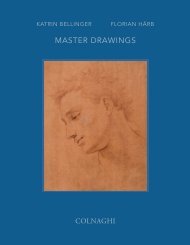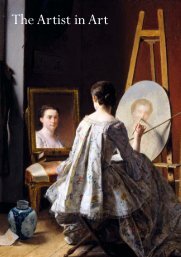2007 Catalogue - Colnaghi
2007 Catalogue - Colnaghi
2007 Catalogue - Colnaghi
Create successful ePaper yourself
Turn your PDF publications into a flip-book with our unique Google optimized e-Paper software.
Provenance: Sale Cardinal Fesch, Rome, 26 March,<br />
1845, no. 786, p. 34 (Le fidèle messager); thence<br />
acquired by Galerie Cailleux, Paris by the grandparents<br />
of the previous owner.<br />
Exhibited: Salon de 1810, Paris, no. 365 (Le petit<br />
messager ou L'occupation interrompue); Les Époques,<br />
Paris, Galerie Charpentier, 1933, no. 81, p. 43.<br />
Literature: A. Bellier de la Chavignerie, Dictionnaire<br />
Général des Artistes de l'école française, Paris, 1882,<br />
p. 638; P. Marmottan, L'Ecole française de peinture,<br />
1789-1830, Paris, 1886, p. 275; J. Doin, Marguerite<br />
Gérard, Gazette des Beaux-Arts, December 1912,<br />
p. 436; S. Wells-Robertson, Marguerite Gérard, New<br />
York University, Ph.D., 1978, vol. II, no. 77,<br />
reproduced.<br />
The <strong>Colnaghi</strong> painting is a fine example of an intimate<br />
interior genre scene by Marguerite Gérard that would<br />
have appealed greatly to the public and the critics of<br />
the period. Although Gérard studied, and may even<br />
have collaborated, with her brother-in-law Jean-<br />
Honoré Fragonard, she appears to have eschewed the<br />
sensuality and eroticism that characterize many of his<br />
later works in favour of a more domesticated and<br />
idealised portrayal of bourgeois and upper-class life. It<br />
is perhaps understandable, given her role as a female<br />
artist, that she focused largely on depictions of women,<br />
usually presented in romantic or maternal roles and<br />
often, as in our picture, accompanied by pets. While<br />
her canvases record the privileged and secluded lives of<br />
educated women of her own time, they also look<br />
forward to the domestic genre scenes that became<br />
popular later in the nineteenth-century.<br />
Le petit messager was part of the celebrated collection of<br />
Cardinal Fesch sold in Rome between 1843 and 1845.<br />
He was perhaps Marguerite Gérard’s greatest admirer,<br />
owning around eleven paintings by her, including the<br />
pendant of ours, A Young Girl arranging Flowers, 1<br />
whose present location is unknown. There are<br />
similarities between the two paintings seen in the<br />
ladies’ hairstyles, the pensive pose of their heads and<br />
25<br />
Marguerite Gérard<br />
(Grasse 1761 – 1837 Paris)<br />
Le Petit Messager<br />
Signed lower right: Mle Gérard<br />
Oil on canvas<br />
24 x 20 in. (61 x 50.5 cm.)<br />
76<br />
the size of the canvases, however it is likely that there<br />
were ten to fifteen years separating these paintings,<br />
with our painting being completed later.<br />
In the <strong>Colnaghi</strong> painting Gerard uses some of her<br />
favourite motifs, such as a young boy peering into the<br />
room from behind a screen which dates to the 1780s, 2<br />
the young woman with a knee on the stool is<br />
reminiscent of an illustration in Les Liaisons<br />
Dangereuses of 17963 and the emotive motif of the<br />
reflective globe appears in Le Chat Angora, 4 currently<br />
with <strong>Colnaghi</strong>. Globes such as this one were objects of<br />
great rarity and value, and its inclusion in another<br />
work by Gérard suggests it was a studio prop belonging<br />
to the artist. 5 It is not clear what the source for this<br />
motif is, although it recalls the interest in reflective<br />
surfaces found in seventeenth- and eighteenth-century<br />
Dutch and Flemish genre scenes and still-lifes (which<br />
probably derives ultimately from the convex mirror in<br />
Van Eyck’s famous Arnolfini Marriage in the National<br />
Gallery, London.)<br />
The influence of such Dutch seventeenth-century<br />
masters as Gerard ter Borch, Gabriel Metsu and Caspar<br />
Netscher, is evident here in the interior setting and its<br />
romantic undertones. Other elements also recall these<br />
petits mâitres hollandaises: the presence of pets, the<br />
elegant rug draped over the table and the meticulous<br />
attention to texture and detail. In Le petit messager the<br />
dog in the lower left corner provides an anecdotal side<br />
to the painting presenting, with its left paw raised, a<br />
rose and a billet doux from the lady’s admirer. It is not<br />
known whether the petit messager belongs to the boy<br />
peeking from behind the screen, the lady’s lover or<br />
admirer or the lady herself. While it is true that such<br />
animals often had an overt symbolic function in<br />
seventeenth century works, it seems unlikely that they<br />
should be interpreted in this way in our painting.<br />
Although dogs often symbolize fidelity in works of this<br />
type, the dog has a more anecdotal role, enlivening the<br />
quiet, restrained mood of the scene that is so typical<br />
of the artist’s oeuvre.








